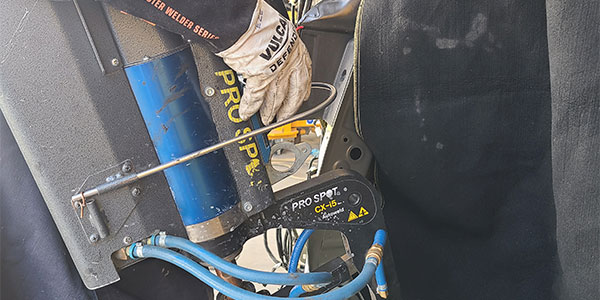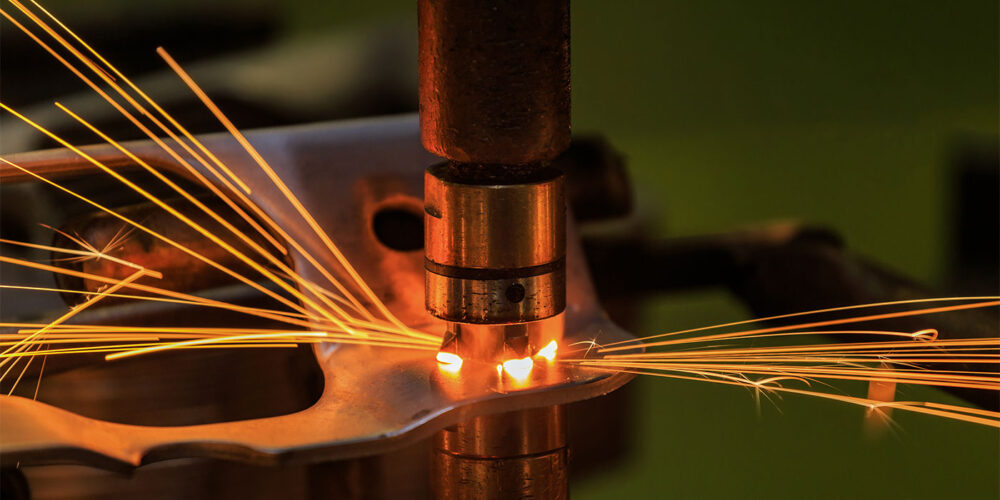Looking back through the years, I remember when squeeze-type resistance spot welder (STRSW) machines started appearing in the collision repair industry. They allowed us to duplicate factory welds on vehicles, retaining the mechanical properties of the metals we were joining.
STRSW was considered one of the biggest changes in the industry. With MIG welding appearing at the same time for aluminum-intensive vehicles, the process of joining metals was making leaps and bounds, representing a huge advancement.
Comparing STRSW and MIG welding, STRSW improved collision repairers’ ability to duplicate the factory build process in so many ways, adding tremendous value to the industry. In addition to all the improvements in repairing vehicles, the industry is seeing STRSW machines that keep improving as far as ease of operation and lower purchase costs, adding to the list of positives STRSW offers.
The Future
When we look at the future of automotive manufacturing, you can see more advanced high-strength steel being designed into vehicles of tomorrow. Making stronger and lighter steels is paramount to efficiency in vehicle motion, whether the vehicle has an internal combustion engine or is electric.
The competition between aluminum and steel is interesting to watch. Steels continue to be competitive as far as cost of manufacturing of raw materials and design for strength, corrosion and longevity of product. The ability to manufacture as well as stamp, shape and bend are attributes that are highly sought after by vehicle manufacturers. Steel is also still top-ranked in recyclability of metals as far as ease, carbon footprint and quantity available. With all of these advantages, we can see clearly how repair procedures will need to retain the properties of the steel and design of the vehicle. This is where STRSW really shines as a repair process of choice — it is a big part of the original build process in today’s vehicles and will be for a while longer.

The steel properties of today and the future will still be a focus on how we look at vehicle repairs. Heat affect zones (HAZ) — no matter how big or small — can have an effect on metal strength or properties. HAZ is also a factor in corrosion protection. These reasons are why STRSW has become the welding method of choice for many applications. The added benefits or features that have made such a huge difference to so many technicians and shops are the ability to duplicate factory welds and the speed at which STRSW makes the weld. The prep time for the weld and weld bonding has a learning curve at first, but experience gained after the first few applications shows that the process reduces the time compared to using plug welds. Anyone who has purchased and used STRSW machines can attest to all of these benefits.
Maintenance
All of this is great as long as the equipment and consumables are maintained. A shop spends a great deal of money to equip a shop with what it needs to complete repairs. In many shops I walk into, I see equipment in need of maintenance or repair, tips that should be replaced, wires that need to be repaired or replaced, and misalignment of pistons or arms. Where did the communication break down on getting equipment back to operating condition and maintaining their operation correctly? In worst-case scenarios, I see technicians trying to use equipment to produce welds and accepting the results as good welds because that is all they have to work with.
Ultimately, this comes down to the shop manager/owner. What program do you have in place to meet with techs to discuss shop equipment needs? Did you get the team (all of them) trained on using the equipment, the importance of maintaining it and how to maintain it? Is there accountability for misuse or abuse of equipment?
Technician morale in any shop is affected by the working condition of the equipment. The quality of work your shop pumps out and your customers’ safety also depend on this. Equipment maintenance is an often overlooked or forgotten piece of shop operations, as so many other things seem to take priority. Plus, it takes a lot of time to keep it all running correctly.. The specific equipment that needs repair and/or maintenance and the status of those repairs is something that should be communicated daily to everyone in the shop.
When management makes a conscientious effort to listen to employee needs, it builds the morale of every shop employee — a necessity to a shop’s success. Losing a technician because of not following through with what it takes to repair a vehicle correctly or not listening to what they need to be efficient is unacceptable. I know that technicians abuse things too, but it’s part of management’s responsibility to find a way to guide or coach that technician on the importance of working for the team and toward success of the shop … or find a technician who does.
Good Welds
Training to make good welds and identify when the weld is not correct is an interesting situation in today’s shops. For many years, we’ve relied on outside training to teach technicians the proper way to weld and understand the “why” of welding during vehicle repairs. As the workforce ages and younger technicians become harder to find, I see a lot of shop helpers come into the industry who may not have gone through tech school or any training but are willing to work and learn. I have no issue with this type of on-the-job training, and I think it’s great as so many potential new technicians slip through our hands because they can’t afford tech college and don’t know what types of grants or scholarships are available. However, we must be careful about the instructions we give on welding. I see many technicians welding on vehicles without understanding what they’re doing; they’re just doing as they’re told and trying to duplicate what their mentor is doing. I’ve seen so many technicians duplicating a joining process without knowing “why” they’re doing what they’re doing and how to make corrections when flaws are occurring.
I applaud the simplicity of STRSW machines and how much automation is being built in because it makes the weld more consistent and of better quality. But I struggle with the idea of technicians not knowing how to troubleshoot or identify when something is wrong and how to correct it. Shops should always take advantage of training offered by the equipment manufacturers or distributors because it is specific to the equipment they’re using, not generalized industry training. Each piece of equipment may have different quirks or advantages as not everyone makes the same equipment. This is also where a shop can develop a maintenance program for that equipment and relationship with the vendor.
I also recommend updated training every year or two for everyone in the shop, including office personnel. Equipment welding processes, settings and maintenance change over time as manufacturers change things and make improvements where a weakness is found or even a new idea is discovered to help technicians. Reinforcing skills and processes is some of the best time spent for shops with the goal of maintaining quality and safety for the shop and its customers. Including everyone in the shop in this training gets everybody on the same page as far as what quality you expect and can help everyone understand and talk intelligently about what it takes to make a correct weld.
Having accountability or structured learning for all technicians in your shop for welding is easy to make and follow:
- Have technicians take equipment or vendor training when possible and repeat every two years for the entire shop.
- Be sure technicians have taken all the I-CAR classes and certifications.
- Check all destructive test welds in the shop on every vehicle and verify the quality of the welds .
- Spot check all technicians to identify if any further coaching or training is needed.
- Meet regularly to discuss shop equipment and maintenance.
Summary
Never assume everything is going perfectly in a shop and being communicated. Conduct your own checklist daily or weekly for weld quality and equipment; this will keep you ahead of any challenges and allow you to correct them before they become a crisis. These simple steps can go a long way toward maintaining your equipment and your shop’s morale, quality and reputation.
A STRSW machine is one of the best investments a shop or technician can make. Knowing how to use and maintain it correctly is a critical piece to that investment.














